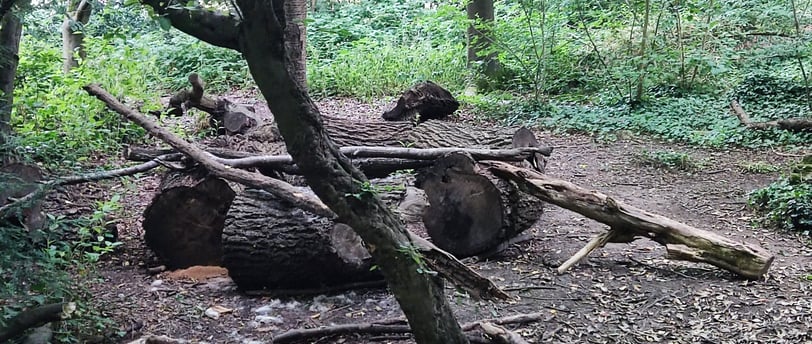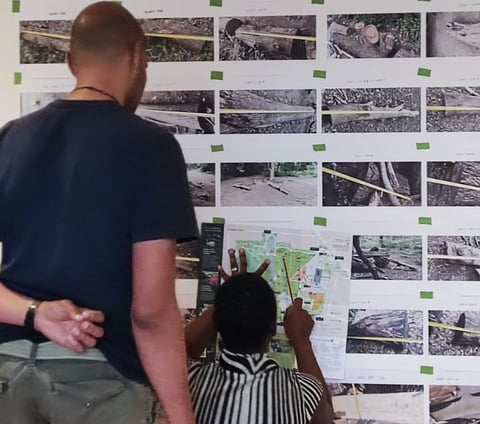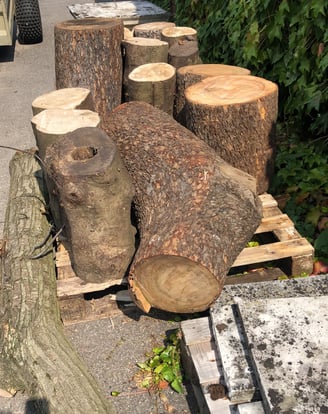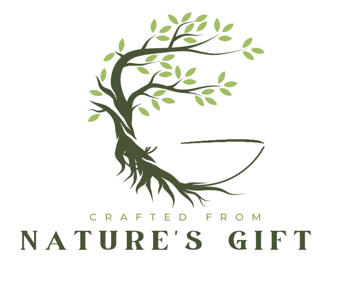Sourcing Materials for the Long Table
Sourcing materials from from the chiswick house grounds. discover how we used fallen trees to create of a stunning handcrafted communal table in the Chiswick House kitchen garden. Explore the beauty and sustainability of this unique project.
7/8/20244 min read


When I first did the proposal and started planning the long table, back in January 2024, the idea was to use reclaimed wood from everyday objects—pallets, old electric cable drums, railway sleepers—anything that had lived a life already and could be transformed into something new. We loved the thought of giving these forgotten pieces a second chance. It was sustainable, creative, and felt like the perfect blend of art and purpose.
But then we met George, one of the team at Chiswick House and Gardens, who took us on a tour of the grounds and show us all the reclaimed wood they had on site As we walked, George pointed out a number of fallen trees—beautiful, weathered, but full of potential. She said 'it would be great if you could use some these'. A new idea was born: what if the table could be made from these trees, ones that had already lived their life on the estate?
Now, here’s where the practical side of things kicked in. Mark—being the logical thinker that he is—wasn’t immediately convinced. This wouldn't just any wood; it was green wood, meaning it was still moist and fresh. For those who don’t know, wood is typically seasoned (dried out) for at least 1 to 2 years before being used, to avoid warping or cracking. So, to Mark, this seemed like a pretty big risk. But I managed to convince him that it would be a great challenge—and Mark, being a fan of any good challenge, was eventually on board. (It also didn’t hurt that I was very persistent and maybe a little persuasive! 😁)
We visited the grounds several times after that, hunting for the perfect logs. We took countless photos, measured the sizes of the trees, and did a lot of research on the types of wood that would work best. It became clear that we were spoilt for choice—so many beautiful logs to choose from, as long as they weren’t too rotten. ⁸ was


At one point, our living room looked like something straight out of a talent scout’s office, with photos of potential logs pinned up, each one competing to be part of our final table. We laughed about how it felt like we were casting roles in a movie, only instead of actors, we were choosing trees! Would it be Yew, holly Cedar Sweet chestnut, what would they be used as? So many questions.


Sustainable Sourcing and Repurposing Nature’s Gifts
As much fun as this process was, it also had a deeper meaning for us. For us, using fallen trees wasn’t just a creative choice; it was about sustainability. These trees had already fallen naturally, and by giving them a second life as part of this project, we were able to reduce waste and avoid cutting down any living trees. The idea of working with materials that nature had already provided was really important to us—it felt ethical, mindful, and respectful to the environment.
Whether it's wood, clay, or any other material, there’s a lot of beauty in what the earth gives us naturally, and often, these materials are just waiting for someone to see their potential, without the need to take more than what’s already available.
By using fallen trees, we’re repurposing materials that would otherwise go to waste. These trees had already lived their lives, offering shade, beauty, and shelter in the gardens. Now, they’ll have a second life as part of something new. It’s a way of honouring the natural cycle, transforming what’s old into something functional and meaningful. Using reclaimed or natural materials means that every piece we create has its own unique story. No two logs are the same. The grain, the knots, the texture—it all tells a tale of where that tree grew and how it weathered the years. When you work with natural materials, you’re not just making something; you’re preserving a piece of history.
The Joy of the Hunt
Finding the right materials for this table has been a blend of adventure, creativity, and problem-solving. It wasn’t just about finding any wood—it was about finding the right wood, with just enough character to bring our vision to life. We’ve embraced every twist and turn in this process, from adjusting our original plans to taking on the challenge of working with green wood
The process of sourcing these materials has really shaped the way we approach creating. It’s made us more aware of how much can be created from things that would otherwise go to waste. It’s also taught us to be patient and flexible—nature doesn’t always give you exactly what you want, but if you look closely, it gives you what you need.
The long table, once finished, will carry the stories of these trees—their history, their age, and their place in the landscape. Each piece of wood will have its own unique character.
And now, as we move into the next phase of actually building the table, we’re excited to see how these once-forgotten trees will transform into something truly special. This project is as much about the journey as it is about the final product, and we’re excited to share both with you.
Nature, Artistry, Sustainability
Transforming nature into beautiful, functional creations.
Harvesting Connections
ayeshaweekes@gmail.com
07958487488
© 2024. All rights reserved.
